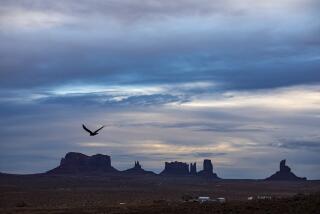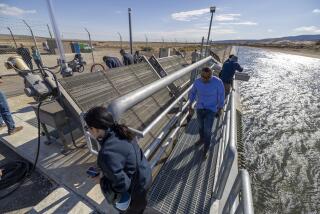Camp Pendleton Battles Low Water Supply : Drought: Military base may be forced to find an outside source of water if dry spell doesn’t end by next year.
- Share via
Camp Pendleton, self-sufficient in its water supply because it recycles treated sewage water, is suffering from California’s drought like everyone else, and may have to find an outside water source if the drought isn’t over by next year.
Mike Malloy, the base’s water resource specialist, said three of four water supply basins at Camp Pendleton are at 30% of their capacity. The fourth basin is at 90% of its capacity.
“I don’t think we’ll have to go to any outside sources right now, but in one more year, we may have to explore some alternate sources,” Malloy said.
Malloy, a civilian who has worked at Pendleton for 12 years, said he doesn’t see the drought coming to a sudden end. He said the water shortage at Camp Pendleton, although as critical as the shortage throughout California, may “demand a closer water conservation management practice” than the rest of the state because the base is self-sufficient.
Malloy said a primary concern lies with Lake O’Neill, the base’s main water backup supply and recreation center.
Lake O’Neill is drained of 1,200-acre-feet of water once a year and relies on rainfall for replenishment. The drained water is released into the lower basin of the Santa Margarita River aquifer, the base’s largest water supply. Runoff from local mountains this winter failed to refill Lake O’Neill, Malloy said.
Pendleton is licensed by the state of California to fill and drain Lake O’Neill annually. The draining of the lake tops off the aquifers and traps the water so it doesn’t run into the ocean.
Col. Jim Turse, assistant chief of staff for facilities at Camp Pendleton, said Lake O’Neill is drained annually as part of an agreement made following a lawsuit concerning water-level rights.
Turse said Camp Pendleton’s ground water is replenished with treated sewage water and released into ponds. The water in the ponds then percolates into water aquifers on the base.
Treated sewage water from Pendleton’s nine waste-water plants is pumped into the four ground-water basins, which are the Santa Margarita, the Las Flores, the San Onofre and the San Mateo basins. The Santa Margarita basin is at 90% of its capacity because it receives more runoff than the other three basins.
Questions have been raised about the safety of recycling sewage water, and Turse said the base is updating its water system in three years to keep up with the latest technology.
“We haven’t had any disease or health problems with this method,” Turse said. “But there is some health risk involved, and we recognize that.”
Camp Pendleton’s water supply is monitored by the state Department of Health Services as well as the Regional Water Quality Control Board, Turse said. He added that the base complies with the same conservation measures that apply to local communities, although it isn’t required to do so.
Col. Dennis Damon, Camp Pendleton chief of staff, said the base has been conserving water for the past two years by installing water-restricting devices in base houses and barracks.
Paul Kanonas, a water quality specialist at Camp Pendleton, said the base is under a “Stage 2” alert, in which water use by base residents is monitored by “water cops,” who give citations to people flooding their lawns or watering down their driveways.
Stage 2 requires that people living in the base’s 6,000 houses water their lawns between 6 p.m. and 10 a.m., and no more than twice a week at three-day intervals.
Kanonas said a meeting is scheduled next week to discuss the possibility of implementing a “Stage 3” alert, which could mandate even stricter regulations. The decision rests with Camp Pendleton’s commanding general, who is expected to issue a ruling the first week of March.
Kanonas said Camp Pendleton residents have been made aware of the water crisis through advertisements in the base’s newspaper.
“Even if San Diego was awash in water, it wouldn’t help us one bit, and we would still have to restrict our consumption here,” Kanonas said. “We have to do something on our water consumption within limits. We are really concerned about our situation.”
More to Read
Sign up for Essential California
The most important California stories and recommendations in your inbox every morning.
You may occasionally receive promotional content from the Los Angeles Times.










